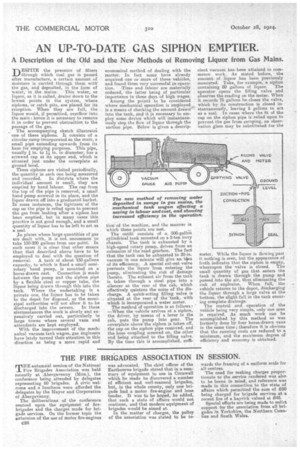AN UP-TO-DATE GAS SIPHON EMPTIER.
Page 10

If you've noticed an error in this article please click here to report it so we can fix it.
A Description of the Old and the New Methods of Removing Liquor from Gas Mains.
ESPITE the presence of filters LI through which coal gas is passed after manufacture, a certain amount of moisture is carried through them with' the gas, and deposited, in the form of water, in the mains: This water, or liquor, as it is called, drains down to the lowest points in the system, where siphons, or catch pits,.ara placed. for its reception. When they are full, the liquor would, if permitted, overflow into the main : hence it. is necessary to remove it in order to prevent obstruction to the passage of the gas.
" The accompanying sketch illustrate; one of these siphons. It consists of a circular sump incorporated in the main, a small pipe extending upwards from its base for emptying purposes. This pipe, usually it in. to 11, in. in diameter, has a screwed cap at its upper end, which is situated met under the eoverplate at ground level.
These siphons are visited periodically, the quantity in each one being measured and recorded. In districts where the individual amount is small, they are emptied by hand labour. The cap from the top of the pipe is removed, a small hand pump screwed in its place, and the liquor drawn off into a graduated bucket. In some instances, the tightness of the cap on the pipe is relied upon to prevent the gas from leaking after a siphon ha i s been emptied, but n many cases this practice is not good enough, and a small quantity of liquor has to be left to act as a seal.
jn places where large quantities of gas are dealt with, it is not uncommon to take 150-200 gallons from one point. In such cases it is clear that other means than that described above have to be employed to deal with the question of removal. A tank of about 150-gallons capacity, to which is fixed a small semirotary hand pump, is mounted on a horse-drawn cart. Connection is made between the pump and the siphon pipe by a flexible steel or copper tube, the liquor being drawn through this into the tank. Where the undertaking is a private one, the liquor has to be taken to the depot for disposal, as the municipal authorities will not allow it to_be
%discharged into the sewers. In these 'circumstances the work is slowly and expensively carried out, particularly in large towns -where several vans and attendants are kept employed.
With the improvement of the mechanical vacuum tank wagon, gas engineers have lately turned their attention in this direction as being a more rapid and economical method of dealing with the matter. In fact some have already acquired one or more of these vehicles, and found them very successful in opera tion. Time and labour are materially reduced, the latter being of particular importance in these days of high wages. Among the point e to be considered where mechanical operation is employed is a means of checking the amount drawn into the tank, and it is necessary to employ some device which will instantaneously stop the flow of liquor through the suction pipe. Below is given a descrip lion of the machine, and the manner in which these points are met. The outfit consists of a, 500-gallon cylindrical tank mounted on a 2-ton lorry
chassis. The tank is exhausted by a high-speed rotary pump, driven from an extension of the road gearbox. The fact that the tank can be exhausted to 20-in. vacuum in one minute will give an iciea of its efficiency. A special cut-out valve prevents the liquor from entering the pump, eliminating the risk of damage thereto. The exhaust air from the tank is taken through a steel pipe into a silencer at the rear of the cab, which effectively quietens the noise of the discharge. .A quick-acting filling valve is situated at the rear of the tank, with which is incorporated a water meter. The method of operation is as follows —When the vehicle arrives at a siphon, the driver, by means of a lever in the cab, puts the pump into gear. The toverplate above the siphon is taken off, the cap on the siphon pipe removed, and the hose coupling screwed on, the other end being attached to the filling valve. By the time this is accomplished, euffi
dent vacuum has been attained to commence work. As stated before, the amount of liquor has been previously measured. Take, for example, a siphon
containing 80 gallons of liquor. The operator opens the filling valve and observes the reading on the meter. When it records 75 gallons he closes the valve, which by its construction is closed instantaneously, leaving 5 gallons to act as a seal. In cases where the fit of the cap on the siphon pipe is relied upon to prevent the gas from escaping, an observation glass may be substituted, for the
meter. While the liquor is flowing pas it nothing is seen, but the appearance of froth indicates that the siphon is empty, whereupon the valve is closed. The small quantity of gas that enters the tank is drawn through the pump and passed into the air, thus eliminating the risk of explosion. When full, the vehicle returns to the depot, discharging the liquor through a large valve at the bottom, the slight fall in the tank ensuring complete drainage. The control and operation of the vehicle being very simple, only one man is required. As, much work can be accomplished by this method as was formerly done by four horse-drawn vans in the same time; therefore it is obvious that the running costs are reduced to a minimum, and the maximum degree of efficiency and economy is obtained.




































